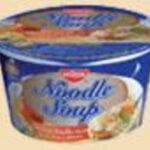The box of Thai Kitchen Noodle Cart Pad Thai was foisted off on me by my 13 year old son. He has developed a passion for easy to prepare Asian lunches that he can bring to school and cook in the mircowave. But after tasting a couple of Thai Kitchen Noodle Cart dishes and finding them lacking, he rebuffed the Thai Kitchen Noodle Cart Pad Thai I had bought for him. How bad could it be, I wondered? I decided to try it myself.
Thai Kitchen Noodle Cart Pad Thai can be prepared in the microwave or with boiling water heated on the stove top. I opted for the boiling water method, thinking it would produce the most desirable results.
Thai Kitchen Noodle Cart Pad Thai is easy to prepare. The box contains a plastic tray with cover, a plastic bag of noodles, a plastic bag of oil, and a bag of seasoning. Preparation requires placing the noodles in the tray, filling the tray with water, and covering it until the noodles soften. Prefabricated holes in the tray lid allow easy removal of the water. The final step in preparing Thai Kitchen Noodle Cart Pad Thai is to pour the oil and seasoning onto the noodles and stir.
On opening the seasoning, I was dismayed at its odd orangey color that reminded me of Georgia clay. Wondering just how much food dye went into this mix, I suspiciously checked the box. To my surprise, there was no mention of any artificial colorings used in Thai Kitchen Noodle Cart Pad Thai. Apparently, the manufacturer somehow managed to create this odd color by combining chili and paprika- I still can’t quite fathom how. I have never seen those spices combined to create such a color before, but come to think of it, I have never seen paprika used in pad thai before, either. There are many laudable uses for paprika in this world; infusing pad thai with the hues of southern mud is not one of them.
My next observation of the Thai Kitchen Noodle Cart Pad Thai spice packet was the overpowering salt smell. This took me back to the box to find out how much salt Thai Kitchen Noodle Cart Pad Thai contained: 560 mg sodium or 23% of the Daily Value.
The contents of the packet were ground u p spices, not a single chunk or visually identifiable foodstuff. No mouth-watering anticipation here. Still, I was willing to give Thai Kitchen Noodle Cart Pad Thai the benefit of the doubt.
I tasted Thai Kitchen Noodle Cart Pad Thai. I tasted salt, overpowering salt. And a ground up sludge of spices with a strong chili flavor. Normally, pad thai does contain a small amount of chili, but Thai Kitchen Noodle Cart Pad Thai seemed to rely on chili and salt almost exclusively for its flavoring. I checked the box again. Thai Kitchen Noodle Cart Pad Thai does not contain some of the distinctive ingredients that define pad thai. It contains no cilantro and no peanuts. It also does not contain egg or bean sprouts. In sum, it is a pretty pathetic excuse for pad thai.
Close perusal of the seasoning packet pretty much states the case against Thai Kitchen Noodle Cart Pad Thai. In descending order, those ingredients include pure cane sugar, tamarind, soybean sauce (made from water, soybeans, salt, cornstarch, maltodextrin, and shallot), more salt- independent of that in the soybean sauce, onion flavor, silicon dioxide, green onions, chili, garlic, paprika, pepper and soybean oil.
This product was inexpensive, under $2.
I would not recommend Thai Kitchen Noodle Cart Pad Thai to anyone with taste buds intact.




